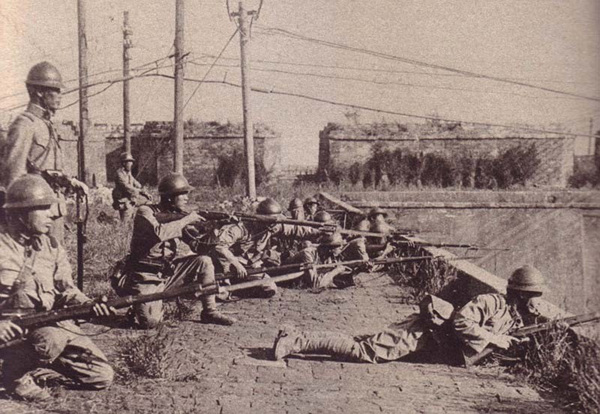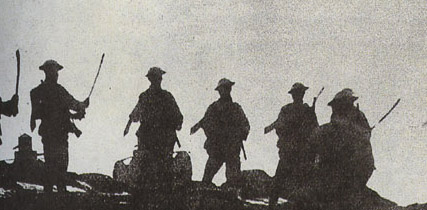|
Taoliao Army
{{Unreferenced, date=May 2019, bot=noref (GreenC bot) Taoliao Army, was the former Hsingan Reclamation Army that had gone over to the Japanese during the invasion of Manchuria. It was involved in Operation Nekka The defense of the Great Wall () (January 1 – May 31, 1933) was a campaign between the armies of Republic of China and Empire of Japan, which took place before the Second Sino-Japanese War officially commenced in 1937 and after the Japanese in ... that captured Rehe. Following which in 1933 it became the Rehe Guard Army. It had the same commander throughout, Chang Hai-peng. The Taoliao Army was part of the Manchukuoan Army formed upon the foundation of the state of Manchukuo. It was composed of at least eight Detachments. The 1st, 4th, 5th, 7th and 8th Detachments are mentioned in Anti Bandit Operations against Feng Zhanhai and Mongolian bandits in the summer of 1932. At the time of Operation Nekka in January 1933, seven Detachments are mentioned as being in t ... [...More Info...] [...Related Items...] OR: [Wikipedia] [Google] [Baidu] |
Hsingan Reclamation Army
Hsingan (; or Xing'an) refers to a former province, which once occupied western Heilongjiang and part of northwest Jilin provinces of China. The name is related to that of the Greater Khingan Mountains. Another name used for this land was Barga, which is also the name used for the western part of the province, the Barga district. Administration The capital of Hsingan was the town of Hailar (or Hulun), on the China Eastern Railway line near the Russian border. Hsingan was divided into various sub-prefectures, similar in form to other Manchukuo provinces. The second city of importance was Manzhouli. History Hsingan province was first created in 1932 as an administrative sub-division of the Japanese-controlled Empire of Manchukuo. From 1939 to 1943, the province was divided into four parts, labeled Hsingan North, Hsingan East, Hsingan South and Hsingan West. These four provinces were reunited into a Xing'an Consolidated Province (興安総省) in 1943. Hsingan at encompassed ne ... [...More Info...] [...Related Items...] OR: [Wikipedia] [Google] [Baidu] |
Japanese Invasion Of Manchuria
The Empire of Japan's Kwantung Army invaded Manchuria on 18 September 1931, immediately following the Mukden Incident. At the war's end in February 1932, the Japanese established the puppet state of Manchukuo. Their occupation lasted until the success of the Soviet Union and Mongolia with the Manchurian Strategic Offensive Operation in mid-August 1945, towards the end of the Second World War. The South Manchuria Railway Zone and the Korean Peninsula had been under the control of the Japanese Empire since the Russo-Japanese War of 1904–1905. Japan's ongoing industrialization and militarization ensured their growing dependence on oil and metal imports from the US. The US sanctions which prevented trade with the United States (which had occupied the Philippines around the same time) resulted in Japan furthering its expansion in the territory of China and Southeast Asia. The invasion of Manchuria, or the Marco Polo Bridge Incident of 7 July 1937, are sometimes cited as an alternat ... [...More Info...] [...Related Items...] OR: [Wikipedia] [Google] [Baidu] |
Operation Nekka
The defense of the Great Wall () (January 1 – May 31, 1933) was a campaign between the armies of Republic of China and Empire of Japan, which took place before the Second Sino-Japanese War officially commenced in 1937 and after the Japanese invasion of Manchuria in 1931. It is known in Japanese as and in many English sources as the First Battle of Hopei. During this campaign, Japan successfully captured the Inner Mongolian province of Rehe from the Chinese warlord Zhang Xueliang, and incorporated it into the newly created state of Manchukuo, whose southern frontier was thus extended to the Great Wall of China. Battle of Shanhai Pass Shanhaiguan is the fortified eastern end of the Great Wall of China, where the Great Wall meets the ocean. Per the terms of the 1901 Boxer Rebellion accord, the Imperial Japanese Army maintained a small garrison of around 200 men at Shanhaiguan. On the night of 1 January 1933, the Japanese garrison commander staged an "incident" by exploding a few ... [...More Info...] [...Related Items...] OR: [Wikipedia] [Google] [Baidu] |
Rehe (province)
Rehe (), also romanized as Jehol, was a former Chinese special administrative region and province. Administration Rehe was north of the Great Wall, west of Manchuria, and east of Mongolia. Its capital and largest city was Chengde. The second largest city was Chaoyang, followed by Chifeng. The province covered 114,000 square kilometers. History Rehe was once at the core of the Khitan-led Liao Dynasty. Rehe was conquered by the Manchu banners before they took possession of Beijing in 1644. Between 1703 and 1820, the Qing emperors spent almost each summer in their summer Mountain Resort in Chengde. They governed the empire from Chengde, and received there foreign diplomats and representatives of vassal and tributary countries. The Kangxi emperor restricted the admission to the forests and prairies of Rehe to the court's hunting expeditions and to the maintenance of the imperial cavalry. Agricultural settlements were at first forbidden to Han Chinese. In the early 19th centur ... [...More Info...] [...Related Items...] OR: [Wikipedia] [Google] [Baidu] |
Rehe Guard Army
The Rehe Guard Army was a corps of the Manchukuo Imperial Army, formed after the conquest of the former Chinese province of Rehe during Operation Nekka in 1933. The Rehe Guard Army was created from a section of the Taoliao Army and had a nominal strength of 17,945 men * Headquarters (301) * Artillery Unit (854) * Cavalry Unit (172) * Infantry Unit (1,294) * Chengde Area Forces (4,783) * Chifeng Area Forces (3,414) * Chaoyang Area Forces (3,977) * Weichang Area Forces (3,150) * Xinjing Cavalry Brigade (2,018) * Seiyan Army (Fangtian Area Forces) (3,760) * River Patrol Unit (640) In the 1935 reorganization of the Manchukuo Imperial Army it became the 5th District Army "Chengde" Fifth is the ordinal form of the number five. Fifth or The Fifth may refer to: * Fifth Amendment to the United States Constitution, as in the expression "pleading the Fifth" * Fifth column, a political term * Fifth disease, a contagious rash tha ... under command of General Chang Hai-peng. Sourc ... [...More Info...] [...Related Items...] OR: [Wikipedia] [Google] [Baidu] |
Chang Hai-peng
Zhang Haipeng (, Hepburn: ''Chō Kaihō''; 1867–1949), was a Chinese Northeastern Army general, who went over to the Japanese during the Invasion of Manchuria and became a general in the Manchukuo Imperial Army of the State of Manchuria. Biography Zhang was a member of the Honghuzi irregular cavalry forces of the Manchurian warlord Feng Delin during the First Sino-Japanese War. These forces were recruited as mercenaries by the Japanese during the Russo-Japanese War from 1904 to 1905. He subsequently studied at the Northeast Military Academy built by Gen. Zhao Erxun. Following the Xinhai Revolution, he was assigned command of an infantry regiment under the Republic of China; however, he supported Zhang Xun's abortive attempt to restore the Qing dynasty in 1917. He afterwards joined forces with Manchurian warlord Zhang Zuolin. In 1923 he was appointed a commissioner of the Chinese Eastern Railway and participated in the First Zhili–Fengtian War. in early 1931 his forces wer ... [...More Info...] [...Related Items...] OR: [Wikipedia] [Google] [Baidu] |
Manchukuo
Manchukuo, officially the State of Manchuria prior to 1934 and the Empire of (Great) Manchuria after 1934, was a puppet state of the Empire of Japan in Northeast China, Manchuria from 1932 until 1945. It was founded as a republic in 1932 after the Japanese invasion of Manchuria, and in 1934 it became a constitutional monarchy under the ''de facto'' control of Japan. It had limited Diplomatic recognition, international recognition. The area was the homeland of the Manchu people, Manchus, including the emperors of the Qing dynasty. In 1931, Japanese invasion of Manchuria, Japan seized the region following the Mukden Incident. A pro-Japanese government was installed one year later with Puyi, the List of emperors of the Qing dynasty, last Qing emperor, as the nominal regent and later emperor. Manchukuo's government was dissolved in 1945 after the Surrender of Japan, surrender of Imperial Japan at the End of World War II in Asia, end of World War II. The territories claimed by Manc ... [...More Info...] [...Related Items...] OR: [Wikipedia] [Google] [Baidu] |
Feng Zhanhai
Feng Zhanhai (, 6 November 1899 – 14 September 1963), or Feng Chan-hai, was one of the leaders of the volunteer armies resisting the Japanese and the puppet state of Manchukuo in northeast China. Feng was born on November 6, 1899. At eighteen he joined the Dongbei Army, and later entered a military school graduating in 1921. After he graduated, he was successively a platoon leader, company commander, and battalion commander. At the time of the Mukden Incident and Japanese invasion of northeast China he was a colonel commanding a regiment of the Kirin Guards Division. After the Mukden Incident, he opposed the Northeast border defense headquarters surrender to the Japanese forces, and commanded his troops on September 19 to withdraw from the Kirin provincial capital, and sent his troops during October to oppose the Japanese, fighting near Binxian. In at the end of January, 1932, Feng joined Ting Chao, Li Du, Xing Zhanqing, Zhao Yi to form the Jilin Self-Defence Army, ... [...More Info...] [...Related Items...] OR: [Wikipedia] [Google] [Baidu] |
Armies Of Manchukuo
An army (from Old French ''armee'', itself derived from the Latin verb ''armāre'', meaning "to arm", and related to the Latin noun ''arma'', meaning "arms" or "weapons"), ground force or land force is a fighting force that fights primarily on land. In the broadest sense, it is the land-based military branch, service branch or armed service of a nation or country. It may also include aviation assets by possessing an army aviation component. Within a national military force, the word army may also mean a field army. In some countries, such as France and China, the term "army", especially in its plural form "armies", has the broader meaning of armed forces as a whole, while retaining the colloquial sense of land forces. To differentiate the colloquial army from the formal concept of military force, the term is qualified, for example in France the land force is called ''Armée de terre'', meaning Land Army, and the air and space force is called ''Armée de l'Air et de l’Espace' ... [...More Info...] [...Related Items...] OR: [Wikipedia] [Google] [Baidu] |



.jpg)
